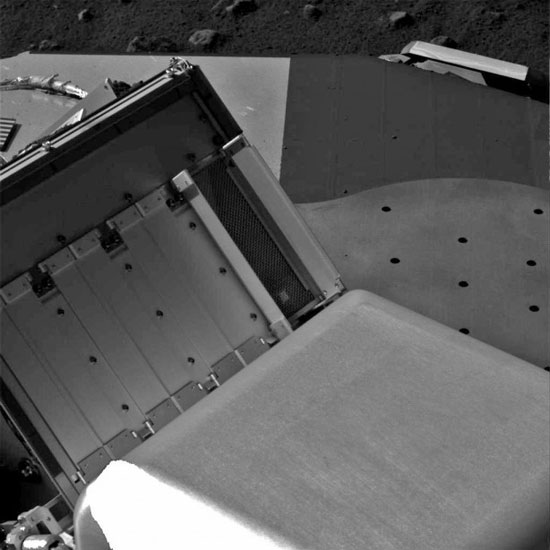Mars Lander Glitch Prevents Dirt-Baking Effort

A scoop of icy soil was collected by NASA's Phoenix Mars Lander's robotic arm but is stuck on the scoop and could not be delivered to the robot's onboard oven.
Engineers determined the rasping and scraping activity collected a total of 3 cubic centimeters of icy soil, more than enough to fill the tiny oven cell of the Thermal and Evolved-Gas Analyzer, or TEGA. However, images returned from the lander Saturday morning show that much of the soil remained lodged in the robotic arm's scoop after the attempt to deliver the sample to the TEGA.
"Very little of the icy sample made it into the oven," said Barry Goldstein, Phoenix project manager from NASA's Jet Propulsion Laboratory in Pasadena, Calif. "We believe that the material that was intended for the targeted cell is the material that adhered to the back of the scoop."
Once the sample had been collected, the robotic arm tilted its scoop and ran the rasp motor several times in an attempt to sprinkle the sample into the oven. The final step was inverting the scoop directly over the wide-open doors. A screened opening over the oven measures about 4 inches (10 centimeters) by 1.5 inches (3 centimeters).
The oven itself is roughly the size of an ink cartridge in a ballpoint pen.
"The good news here is TEGA is functioning nominally, and we will adjust our sample drop-off strategy to run this again," Goldstein said.
Prior to the sample delivery, Phoenix's robotic arm made 16 holes in the hard ground with its motorized rasp tool and the scoop collected the rasped material and shavings left on the surface from the rasping action.
Get the Space.com Newsletter
Breaking space news, the latest updates on rocket launches, skywatching events and more!
The lander conducted these activities overnight Friday to Saturday, Pacific Time, during Martian morning hours of the mission's 60th Martian day, or sol. The Phoenix team planned Saturday to send the spacecraft commands to take images on Sunday, the mission's Sol 61, of areas around and under the TEGA instrument. The images by the Robotic Arm Camera would be a way to check for additional material that might have been released by the scoop on Sol 60.
The aim of the $420 million mission, which landed on May 25, is to characterize the dirt and icy layer that lies below it in the north polar regions of Mars to look for signs that the planet might have been habitable at some point in the past. Mission scientists have applied to NASA to extend the mission past its originally-slated 90 days.
- Video: Digging on Mars
- Earth vs. Mars: Polar Opposites
- Images: Phoenix on Mars!
Join our Space Forums to keep talking space on the latest missions, night sky and more! And if you have a news tip, correction or comment, let us know at: community@space.com.

Space.com is the premier source of space exploration, innovation and astronomy news, chronicling (and celebrating) humanity's ongoing expansion across the final frontier. Originally founded in 1999, Space.com is, and always has been, the passion of writers and editors who are space fans and also trained journalists. Our current news team consists of Editor-in-Chief Tariq Malik; Editor Hanneke Weitering, Senior Space Writer Mike Wall; Senior Writer Meghan Bartels; Senior Writer Chelsea Gohd, Senior Writer Tereza Pultarova and Staff Writer Alexander Cox, focusing on e-commerce. Senior Producer Steve Spaleta oversees our space videos, with Diana Whitcroft as our Social Media Editor.









